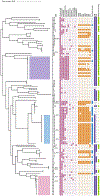Functional genomics of antibiotic susceptibility in Enterococcus faecalis from infective endocarditis
- PMID: 40444324
- PMCID: PMC12318496
- DOI: 10.1093/infdis/jiaf272
Functional genomics of antibiotic susceptibility in Enterococcus faecalis from infective endocarditis
Abstract
Enterococcus faecalis is an opportunistic pathogen that causes infective endocarditis. Despite in vitro synergy of the recommended combination ampicillin and ceftriaxone (AC), E. faecalis infective endocarditis (EFIE) mortality remains high. We characterized 119 isolates from EFIE patients in our health system from 2018 to 2023 genomically and phenotypically. Three genetic lineages (ST6, ST40, and ST179) accounted for 41% of all infections. ST6 isolates were less susceptible to ceftriaxone and AC in dual-antibiotic checkerboard assays, but also exhibited decreased survival in dual-antibiotic killing assays using humanized AC exposures. ST6 isolates encoded a known genetic disruption affecting pbp4 as well as mutation of a putative hydrolase called phnP. Functional studies confirmed that both alterations contributed to altered AC susceptibility. Finally, we found that ampicillin plus daptomycin showed robust growth inhibition and killing against EFIE isolates with decreased AC susceptibility. These findings enhance our understanding of EFIE and may guide better therapeutic strategies.
Keywords: Enterococcus faecalis; antibiotic resistance; ceftriaxone; endocarditis.
© The Author(s) 2025. Published by Oxford University Press on behalf of Infectious Diseases Society of America. All rights reserved. For commercial re-use, please contact reprints@oup.com for reprints and translation rights for reprints. All other permissions can be obtained through our RightsLink service via the Permissions link on the article page on our site—for further information please contact journals.permissions@oup.com.
Conflict of interest statement
Dr. Shields has served as a consultant to Merck, Shionogi, AbbVie, Biomerieux, Menarini, GlaxoSmithKline, Entasis, and Venatorx, and received research support from Merck, Shionogi, Melinta, Roche, Innoviva and Venatorx. All other authors have no relevant conflicts of interest to report.
All authors have submitted the ICMJE Form for Disclosure of Potential Conflicts of Interest. Conflicts that the editors consider relevant to the content of the manuscript have been disclosed.
Figures






Similar articles
-
In vitro activity of ceftobiprole plus ampicillin against Enterococcus faecalis causing infective endocarditis: phenotypic and genotypic characterization.J Antimicrob Chemother. 2025 Sep 3;80(9):2513-2523. doi: 10.1093/jac/dkaf260. J Antimicrob Chemother. 2025. PMID: 40693491
-
Differential in vitro susceptibility to ampicillin/ceftriaxone combination therapy among Enterococcus faecalis infective endocarditis clinical isolates.J Antimicrob Chemother. 2024 Apr 2;79(4):801-809. doi: 10.1093/jac/dkae032. J Antimicrob Chemother. 2024. PMID: 38334390 Free PMC article.
-
Antibiotic prophylaxis for preventing bacterial endocarditis following dental procedures.Cochrane Database Syst Rev. 2022 May 10;5(5):CD003813. doi: 10.1002/14651858.CD003813.pub5. Cochrane Database Syst Rev. 2022. PMID: 35536541 Free PMC article.
-
A comparison of different antibiotic regimens for the treatment of infective endocarditis.Cochrane Database Syst Rev. 2016 Apr 19;4:CD009880. doi: 10.1002/14651858.CD009880.pub2. Cochrane Database Syst Rev. 2016. Update in: Cochrane Database Syst Rev. 2020 May 14;5:CD009880. doi: 10.1002/14651858.CD009880.pub3. PMID: 27092951 Updated.
-
Evaluation of ampicillin plus ceftobiprole combination therapy in treating Enterococcus faecalis infective endocarditis and bloodstream infection.Sci Rep. 2025 Jan 28;15(1):3519. doi: 10.1038/s41598-025-87512-8. Sci Rep. 2025. PMID: 39875507 Free PMC article.
References
-
- Fernández-Hidalgo N, Escolà-Vergé L, Pericàs JM. Enterococcus faecalis endocarditis: what’s next? Future Microbiol 2020; 15:349–64. - PubMed
-
- Pericàs JM, Llopis J, Muñoz P, et al. A contemporary picture of enterococcal endocarditis. J Am Coll Cardiol 2020; 75:482–94. - PubMed
-
- Gilmore MS, Clewell DB, Ike Y, Shankar N. Enterococci: from commensals to leading causes of drug resistant infection. Boston: Massachusetts Eye and Ear Infirmary, 2014. - PubMed
-
- Baddour LM, Wilson WR, Bayer AS, et al. Infective endocarditis in adults: diagnosis, antimicrobial therapy, and management of complications. Circulation 2015; 132: 1435–86. - PubMed
Grants and funding
LinkOut - more resources
Full Text Sources

